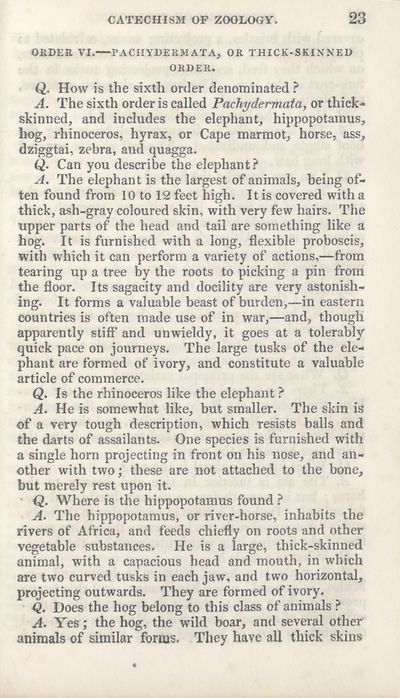Download files
Complete book:
Individual page:
Thumbnail gallery: Grid view | List view

CATECHISM OP ZOOLOCP.
23
ORDER VI. PACHYDERM AT A, OR THICK-SKINNED
ORDER.
Q. How is the sixth order denominated ?
A. The sixth order is called Paehydermata, or thick-
skinned, and includes the elephant, hippopotamus,
hog, rhinoceros, hyrax, or Cape marmot, horse, ass,
dziggtai, zebra, and quagga.
Q. Can you describe the elephant?
A. The elephant is the largest of animals, being of¬
ten found from 10 to 12 feet high. It is covered with a
thick, ash-gray coloured skin, with very few hairs. The
upper parts of the head and tail are something like a
hog. It is furnished with a long, flexible proboscis,
with which it can perform a variety of actions,—from
tearing up a tree by the roots to picking a pin from
the floor. Its sagacity and docility are very astonish¬
ing. It forms a valuable beast of burden,—in eastern
countries is often made use of in war,—and, though
apparently stiff and unwieldy, it goes at a tolerably
quick pace on journeys. The large tusks of the ele¬
phant are formed of ivory, and constitute a valuable
article of commerce.
Q. Is the rhinoceros like the elephant ?
A. He is somewhat like, but smaller. The skin is
of a very tough description, which resists balls and
the darts of assailants. One species is furnished with
a single horn projecting in front on his nose, and an¬
other with two; these are not attached to the bone,
but merely rest upon it.
Q. Where is the hippopotamus found ?
A- The hippopotamus, or river-horse, inhabits the
rivers of Africa, and feeds chiefly on roots and other
vegetable substances. He is a large, thick-skinned
animal, with a capacious head and mouth, in which
are two curved tusks in each jaw, and two horizontal,
projecting outwards. They are formed of ivory.
Q. Does the hog belong to this class of animals ?
A. Yes; the hog, the wild boar, and several other
animals of similar forms. They have all thick skins
23
ORDER VI. PACHYDERM AT A, OR THICK-SKINNED
ORDER.
Q. How is the sixth order denominated ?
A. The sixth order is called Paehydermata, or thick-
skinned, and includes the elephant, hippopotamus,
hog, rhinoceros, hyrax, or Cape marmot, horse, ass,
dziggtai, zebra, and quagga.
Q. Can you describe the elephant?
A. The elephant is the largest of animals, being of¬
ten found from 10 to 12 feet high. It is covered with a
thick, ash-gray coloured skin, with very few hairs. The
upper parts of the head and tail are something like a
hog. It is furnished with a long, flexible proboscis,
with which it can perform a variety of actions,—from
tearing up a tree by the roots to picking a pin from
the floor. Its sagacity and docility are very astonish¬
ing. It forms a valuable beast of burden,—in eastern
countries is often made use of in war,—and, though
apparently stiff and unwieldy, it goes at a tolerably
quick pace on journeys. The large tusks of the ele¬
phant are formed of ivory, and constitute a valuable
article of commerce.
Q. Is the rhinoceros like the elephant ?
A. He is somewhat like, but smaller. The skin is
of a very tough description, which resists balls and
the darts of assailants. One species is furnished with
a single horn projecting in front on his nose, and an¬
other with two; these are not attached to the bone,
but merely rest upon it.
Q. Where is the hippopotamus found ?
A- The hippopotamus, or river-horse, inhabits the
rivers of Africa, and feeds chiefly on roots and other
vegetable substances. He is a large, thick-skinned
animal, with a capacious head and mouth, in which
are two curved tusks in each jaw, and two horizontal,
projecting outwards. They are formed of ivory.
Q. Does the hog belong to this class of animals ?
A. Yes; the hog, the wild boar, and several other
animals of similar forms. They have all thick skins
Set display mode to:
![]() Universal Viewer |
Universal Viewer | ![]() Mirador |
Large image | Transcription
Mirador |
Large image | Transcription
| Antiquarian books of Scotland > Curiosities & wonders > Catechism of zoology, or, Natural history of the animal kingdom > (41) |
|---|
| Permanent URL | https://digital.nls.uk/113571346 |
|---|
| Description | Thousands of printed books from the Antiquarian Books of Scotland collection which dates from 1641 to the 1980s. The collection consists of 14,800 books which were published in Scotland or have a Scottish connection, e.g. through the author, printer or owner. Subjects covered include sport, education, diseases, adventure, occupations, Jacobites, politics and religion. Among the 29 languages represented are English, Gaelic, Italian, French, Russian and Swedish. |
|---|

